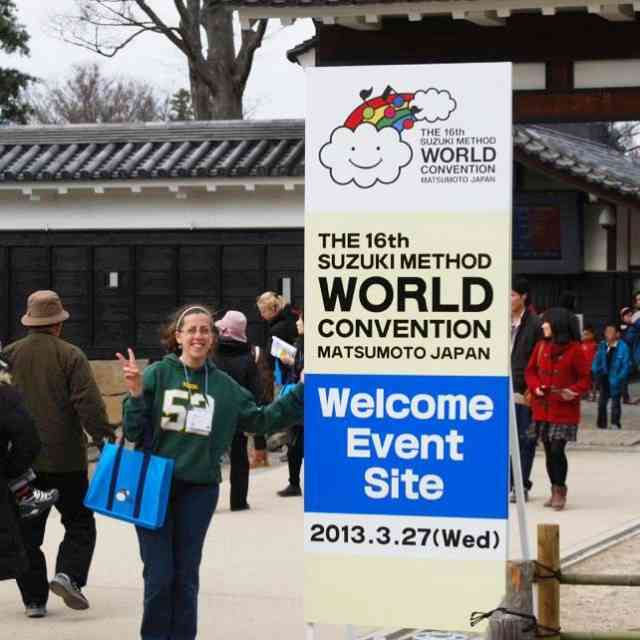By Gabriela Fogo
The Suzuki Method, created in the 1950s by Shinichi Suzuki, has gained widespread popularity and has continued to grow steadily until today. Introduced in the United States in the 1960s, it gained particular attention in 1964 when Suzuki took his students on tour to perform at the Music Educators National Conference in Philadelphia. The performance caught the attention of educators and contributed to the method’s increasing popularity. It started attracting more students and increasing interest in teacher training through summer institutes, workshops, and long-term programs for intensive training at universities. In 1986, prominent music educator John Kendall stated his belief in the Suzuki Method’s signs of continued development, refinement, and adaptability: “The imaginative, creative energy of the Suzuki Method, which has stirred children, parents, and teachers so profoundly in the past twenty-five years, is likely to continue to affect the musical education of generations to come.”1
With the astonishing number of approximately 400,000 students learning instruments through the Suzuki Method, John Kendall’s predictions about the method’s growth seem to be true. In addition to its impressive growth, the method has successfully trained highly qualified musicians, including some distinguished musical figures of the contemporary musical scene. As the Suzuki Method continues its prominence and development, it is useful to reexamine its core elements with a particular emphasis on its adaptability and incorporating a more diverse array of works into the repertoire. Following this examination, I will describe two supplemental repertoire selections from the many I’ve gathered in my research that highlight this concept of adaptability and diversity.
The Suzuki Philosophy and Core Repertoire
Suzuki’s philosophy is rooted in the “mother-tongue” concept, which links the learning of musical instruments with language acquisition. Suzuki believed that just as children learn to speak their native language by listening and repeating, they can learn how to play an instrument, emphasizing the importance of listening and repetition in the learning process. He also advocated for a positive environment where children have constant exposure to music and can listen to recordings of pieces from an early age. Parental involvement in the learning process and a thriving and motivating environment are fundamental concepts of Suzuki’s philosophy.2 With these concepts in mind, Suzuki carefully planned the repertoire, selecting the works presented in ten volumes of the violin method to reflect his philosophy. A core concept is the presentation of new elements in small bits so students can consciously master them. The chosen pieces provide many opportunities for repetition while gradually introducing new elements. The repertoire sequence allows for steady and constant improvement, breaking down the learning process of more advanced repertoire into many small steps. Suzuki designed the sequence of songs to build technique and musicianship.
The core repertoire throughout the ten violin books comprises folk songs, arrangements, and compositions drawn from the standard Western repertoire. The explanation for the chosen repertoire comes from Suzuki’s music education and instruction. His teachers’ musical backgrounds trace back to European pedagogues, like Joseph Joachim, and Suzuki followed the same path and traveled to Germany to study violin. Even before Suzuki formally studied the violin, he was familiar with Western music from his childhood experiences.
Western music was brought into Japan in the nineteenth century, and music textbooks included European songs since the 1880s. Songs like “Lightly Row” were familiar to Japanese children as part of the music textbooks in Japanese public schools.3 When selecting these songs, Suzuki looked for melodies that were familiar to Japanese children. Some of these folk songs were also present in American and German textbooks. Even though the lyrics and texts for these songs could change from place to place, the melodies remained the same. In summary, these melodies were popular and well-known in many cultures when Suzuki curated this selection. He also selected these pieces because they were written on a well-tempered scale, allowing for the early introduction of concepts that would lead to the advanced standard repertoire he selected for children to learn through his method.4
Suzuki thoughtfully designed the books to introduce specific skills, carefully deliberating how and when to include each. Volume One includes six folk songs, five pieces by Suzuki, and arrangements for violin of pieces by J. S. Bach, R. Schumann, and F. J. Gossec. Suzuki’s early books focus on developing fundamental technical skills through the repertoire, while the later ones follow a more traditional lesson format where the technical skills serve the music. From Book Five onward, each book includes a preface emphasizing that “a well-rounded student’s lesson should include additional studies on shifting, vibrato, double-stops, and reading.”5 Some of the technical skills developed throughout Book One include the introduction of foundational bow strokes such as detaché and martelé, as well as different articulations, and different finger patterns. For instance, “Song of the Wind” introduces the bow retake, while “May Song” presents a new rhythm pattern.6 One notable aspect of Book One is the presence of only three keys throughout: A, D, and G major. These keys allow both teacher and student to reinforce specific finger patterns, providing ample opportunities for the student to listen to the ringing tones while developing other skills.
Suzuki’s philosophy also assumes that children are familiar with the melodies because they have listened to the recordings and seen other children perform the pieces. As a result, they can focus on learning and mastering technical skills while also focusing on the beauty of tone. A close look at the pieces shows that they are organized in a sequential way that introduces a new skill or technique, offers ample opportunity for repetition, and progressively adds new material.
Flexibility and Adaptability
While the method’s sequence and pedagogy are thoroughly planned, it allows for flexibility regarding playing technique. Nancy Brooks highlights Suzuki’s approach and adaptability:
It is interesting to note that Dr. Suzuki himself changes techniques (such as bow arm height) from time to time, a sure indication that specific techniques are not the essence of his approach. We are prone to latch onto Suzuki’s whole body of thought as we first learn it and hold it inflexibly. One who does this may eventually find himself outdated. Dr. Suzuki does not stand still. One is reminded of the student who said, “Sir, in your lecture you contradicted what you wrote in your book!” Professor: “When was my book published?” Student: “Five years ago.” Professor: “Five years is a long time in the life of a thinking man.”7
There is room for adaptability not only in terms of technique but also in terms of repertoire and format. When discussing the repertoire of the Suzuki books and the potential for adaptability, Brooks uses the United States as an example, suggesting that a contemporary American teacher could incorporate fiddle songs and “must take responsibility for enlarging the Suzuki repertoire appropriately.”8 In the second part of this article, published in the subsequent issue, Brooks continues to explore the Suzuki Method and, when referring to the repertoire, she affirms that “the imaginative teacher can make up studies which derive from the problems in a particular piece.”9
John Kendall discusses the role of school orchestra directors in his article and how they can combine the different levels of students, stating: “Imaginative directors have found various ways of involving Suzuki students and, in the long run, they enhance the performance level of the entire group.”10
In the conclusion of her article, Howe states the following regarding repertoire:
Because of the present concern for multiculturalism in education today, Suzuki teachers should use folk songs from many cultures. They can also select tunes to teach the musical concepts of the Suzuki Method. Teachers should choose songs from a student’s cultural tradition so they are familiar.11
The Suzuki repertoire primarily consists of pieces from the Baroque and Classical periods across all ten volumes of the Suzuki Method. These selections were taken from the standard repertoire and meticulously curated. However, as Suzuki pointed out, adaptation is necessary and encouraged over time. Suzuki himself used supplementary repertoire beyond the books’ repertoire. Currently, the Suzuki Association of Americas provides a list of suggested supplementary material, new recordings and updated and revised editions of the books. None of these resources, though, offer many options outside of the standard violin literature. In the spirit of Suzuki’s emphasis on adaptability, my research has been devoted to creating a graded selection of violin compositions by Latin American composers to serve as a supplemental selection alongside the Suzuki repertoire.12 In the space below, I have highlighted two Latin American works that supplement the early Suzuki violin repertoire.
Miniaturas Violinísticas: Peças Fáceis para Violino e Piano by Carlos de Almeida
Beginner Level, Books 1–2
Carlos Vianna de Almeida (1906–1990) was a Brazilian violinist, conductor, violin, and viola teacher born in Rio de Janeiro. A student of Francisco Braga—a prominent composer of the Brazilian Romantic period—Almeida enjoyed a successful and versatile career acting as a teacher, composer, and pianist of popular Brazilian genres, recording instrumental and song compositions.
Almeida’s career as a composer started with Caprichosa for violin and piano. After that, he composed several other pieces for violin and piano, ranging from beginner works to advanced showpieces. His compositional style reflects the music of Rio de Janeiro in the first half of the twentieth century, marked by its melodic character and the use of syncopation. During the last years of his life, Almeida dedicated exclusively to teaching violin at the Conservatório Brasileiro de Música until his death in 1990.13
Miniaturas Violinísticas, composed around 1964, consists of four short movements, all entirely in the first position. Each movement is inspired by popular musical styles of the time.
I. Melodia: Beginner Level, Book 1
Melodia is the first movement of the set. The violin line remains in the first position throughout the piece, only using the D and A strings. The movement (ex. 1) is in the key of D major, utilizing the following finger pattern for most of the composition: 1 23 4 (with a half step between the second and third fingers). The fourth finger is occasionally needed, and there is a singular instance of a lowered second finger (half step between first and second fingers).
This movement emphasizes legato bow strokes and slurs with primarily slow string crossings. It is executed by moving the entire arm to the following string. There are two instances of faster-paced string crossings in measures 21 and 29 (ex. 2), requiring smaller and more precise movements. In addition to these technical aspects, this composition offers opportunities to teach bow distribution to highlight phrasing, shaping, and dynamics.
When comparing the skills needed to play Melodia with the sequence of songs in Suzuki Book One, this piece fits approximately the middle of the book. The D string is introduced in the Suzuki repertoire in the seventh piece, Long Long Ago, and is used more extensively in Allegretto. Until then, the Suzuki repertoire has explored the A and E strings and the finger patterns that use a high second finger (whole step between first and second finger). With the addition of the D string, the same finger pattern extends to three strings. The key of G major is introduced in Etude where students start using a lowered second finger, a skill also required in Melodia. The introduction of the G major scale is crucial for the following songs in the Suzuki sequencing.
The first required use of the fourth finger in the Suzuki repertoire happens in Minuet No. 3 with the pitch B on the E string. Before this, the printed music suggested instances where the fourth finger could be used, but those same pitches could have been played with open strings. Teachers should consider introducing the skill before it is required, thus providing the student with many opportunities to refine it.
The legato bow stroke can be introduced at the beginning of Suzuki Book One. As the bow stroke evolves throughout the book, songs closer to the end will require a variety of bow strokes that the teacher and the student can develop together through the songs, scales, printed exercises, and additional personalized exercises. Slurs are introduced in the Suzuki repertoire only in Minuet No. 2. Prior to this piece, students encountered bowings in the same direction but with separation. From Minuet No. 2 onward, virtually all pieces will have slurs.
While finding literature that aligns with the technical goals of Suzuki’s Books One and Two can be challenging, Miniaturas Violinísticas is an excellent piece for students at this level, as it shares many common techniques with Suzuki literature in the first two books.
II. Toada: Beginner Level, Books 1–2
The second movement of this work is titled Toada. The Toada is a genre of song without a fixed form distinguished by its melodious and dolent character.14 The tempo marking is Moderato, and the violin line is repetitive, reflecting the simplicity of the genre. In contrast, the piano accompaniment is characterized by its syncopated character, a common feature in various Brazilian popular music musical genres.
The technical skills required to play this movement are comparable to those of the first movement. The G major finger pattern is employed, requiring the use of both high and low second fingers. In this movement, the high and low second finger changes occur more frequently, requiring a more refined hand frame. There is one single instance of a lowered first finger that happens towards the end of the movement.
The bow patterns and types of string crossings are similar to those found in the first movement. However, in contrast to the first movement, where the rhythmic pattern of a dotted quarter note followed by an eighth note presents itself under a slur, here it is separate, requiring more awareness of bow distribution. Example 3 illustrates the skills discussed in the past two paragraphs.
The music has many dynamic markings, providing opportunities to explore bow distribution and potential experimentation with contact points. The piano accompaniment is active, marked by syncopation and off-beat passages requiring special attention to the rhythm. Toada fits alongside Suzuki Book One or Two. It can be used to introduce the lowered first finger or added after the student is familiar with the skill. Either way, most of the techniques presented in the piece have already been explored throughout Book One.
Conclusion
As the Suzuki Method aims to be a Talent Education approach rather than just a violin method, it allows for adaptability. Teachers can successfully adapt the fundamental ideas to different teaching settings. They can also explore a broader repertoire outside the canon literature, adapting or supplementing the Suzuki repertoire as desired. By incorporating flexibility into their teaching, educators can contribute to expanding supplemental material that encompasses a more diverse selection of compositions and composers while addressing students’ varied cultural backgrounds and their technical and musical needs.
Notes
1. John Kendall, “Suzuki’s Mother Tongue Method,” Music Educators Journal 72, no. 6 (February 1986): 50.
2. Kendall, “Suzuki’s Mother Tongue,” 48.
3. Sondra Wieland Howe, “Sources of the Folk Songs in the Violin and Piano Books of Shinichi Suzuki,” The Bulletin of Historical Research in Music Education 16, no. 3 (May 1995): 182.
4. Howe, “Sources of the Folk Songs,” 177-193.
5. Shinichi Suzuki, Suzuki Violin School, 10 vols., (Miami: Summy-Bichard, Inc., 2007).
6. Howe, “Sources of the Folk Songs,” 191.
7. Nancy Greenwood Brooks, “Toward a Deeper Understanding of Suzuki Pedagogy,” American Music Teacher 30, no. 1 (1980): 22.
8. Brooks, “Toward a Deeper Understanding,” 22.
9. Nancy Greenwood Brooks, “Toward a Deeper Understanding of Suzuki Pedagogy,” American Music Teacher 30, no. 2 (1980): 28.
10. Kendall, “Suzuki’s Mother Tongue,” 49.
11. Howe, “Sources of the Folk Songs,” 193.
12. Gabriela Da Silva Fogo, “Graded Selection of Violin Compositions by Latin American Composers to Supplement the Suzuki Repertoire” (doctoral thesis, FSU, 2024), https://purl.lib.fsu.edu/diginole/DaSilvaFogo_fsu_0071E_18709.
13. Roberto Carelli, “Carlos de Almeida (Violinista e Compositor),” Canal Roberto Carelli, https://robertocarelli.com.br/carlosdealmeida.html (acessed January 15, 2024).
14. Enciclopédia Itaú Cultural, s.v. “Toada,” https://enciclopedia.itaucultural.org.br/termo14244/toada (accessed February 4, 2024).
Register for the Annual General Meeting!
Jul 19, 2024








